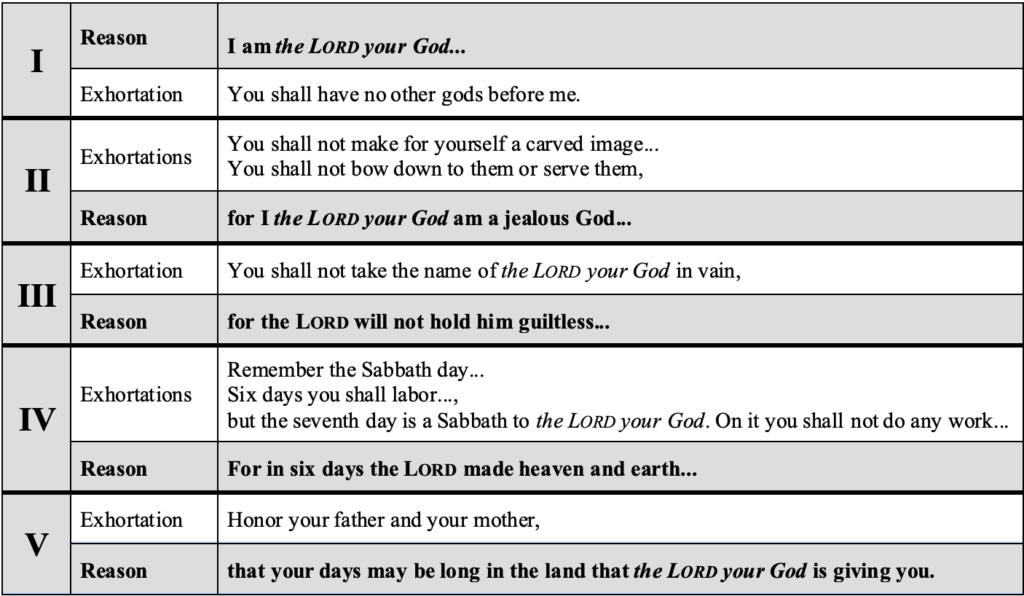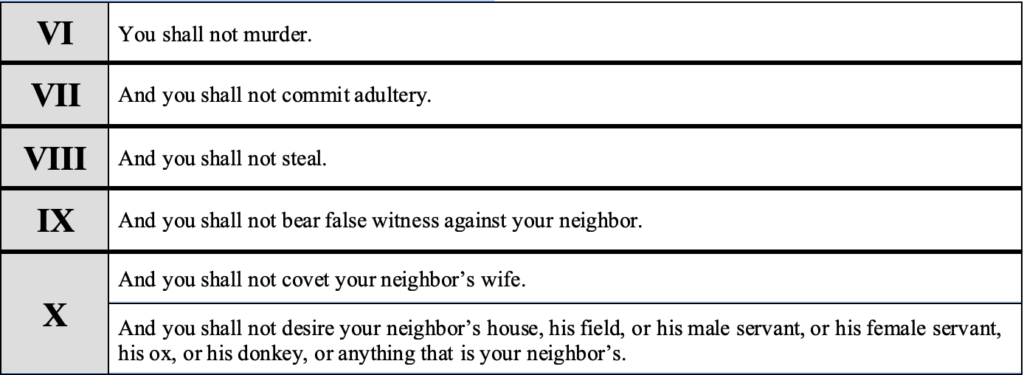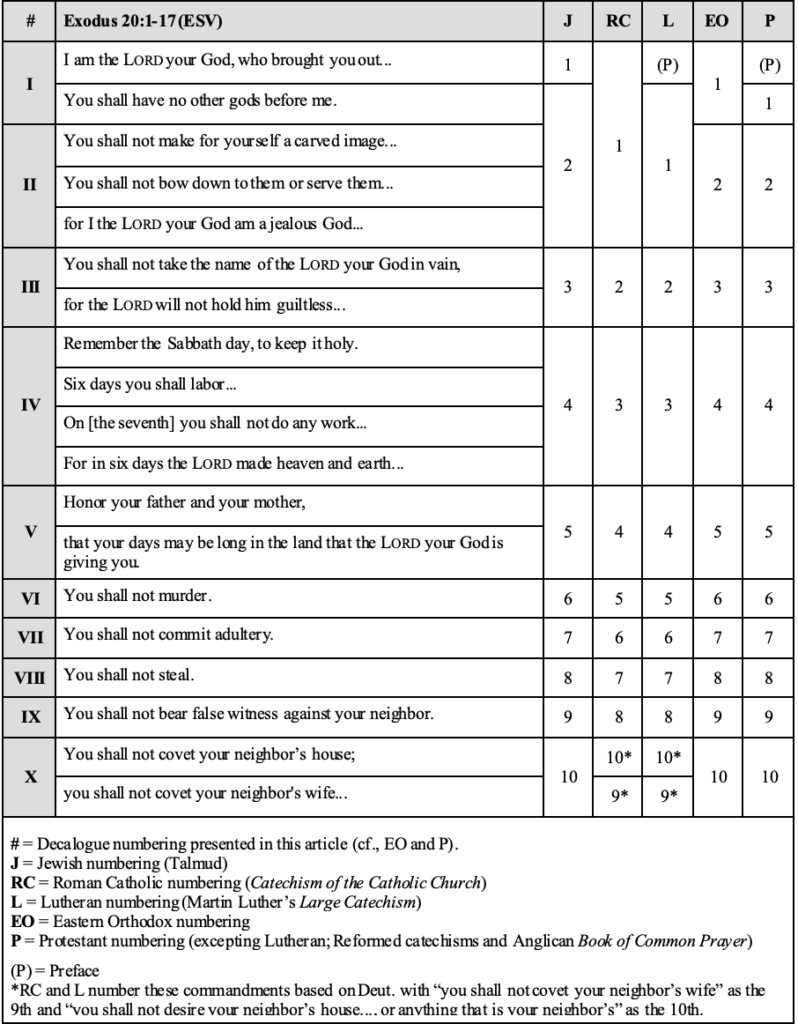Which Ten? How We Number the Ten Commandments Matters
Read the longer, more academic version of this article here.
Punctuation matters. In 1872, Congress learned just how much it matters—in dollars—when it passed a list into law with a misplaced comma.
The bill in question identified products for tax-free import. One item on the list was “fruit plants.” At least, that’s what was intended. But an accidental comma appeared in the final version. It said “fruit, plants” instead. As a result, the American market was mistakenly opened to foreign-grown oranges, grapes, and other fruits duty-free. That typo cost the government $2 million in revenue, equivalent to $43 million today. Punctuation matters.
Enjoying this article? Read more from The Biblical Mind.
There is another list of laws where punctuation matters: the Ten Commandments (also called the Decalogue, meaning “Ten Words”). That series of commands is specifically said to number ten. God “declared to you his covenant . . . that is, the Ten Commandments” (Deut. 4:13). But the passage actually contains fourteen or fifteen exhortations, not just ten. Interpreters must therefore discern which exhortations are grouped together to give us Ten Commandments. Different traditions make those arrangements differently (see table at the end of this article).
Typically, these decisions are made subjectively, by discerning which sentences seem to go best together. But in this article, I want to point out objective markers for the Decalogue’s punctuation. There are at least three places in the Ten Commandments where punctuation needs to be clarified with important implications for interpretation.
Worship and the First Commandment(s)
The Decalogue has two parts. It begins with commands about loving God and ends with commands about other people. The opening sentences of the first part (about loving God) introduce its leading topic: worship. They also present the trickiest section to punctuate with implications for how we understand worship.
The Decalogue begins with a statement: “I am the Lord your God, who brought you out of the land of Egypt, out of the house of slavery” (Exod. 20:2). Three exhortations follow:
- “You shall have no other gods before me.”
- “You shall not make for yourself a carved image . . .”
- “You shall not bow down to them or serve them . . .” (Exod. 20:3–6).
There are two ways in which those opening exhortations are usually grouped.
First, some traditions combine all three instructions into a single commandment based on their shared interest in worship. Often in this reading, all three prohibitions (“no other gods” + “no graven images” + “no bowing to images”) together form the First Commandment.
Second, other traditions discern two commandments here, concerning whom to worship and how to worship. The prohibition against “other gods” stands alone as the First Commandment (whom to worship). And the prohibitions about images (“not making them” + “not bowing to them”) are then joined into the Second Commandment (how to worship). These different ways of grouping the opening exhortations can also tend toward different interpretations.
When all three exhortations are grouped as one commandment, the subject of the first prohibition (“other gods”) remains the likely subject for the rest. The result is a commandment primarily against other gods: you shall not have other gods nor have idols of other gods.When, however, the exhortations are formed into two commandments—first whom to worship (“no other gods”) and second how to worship (“neither make nor use images”)—the Second is aimed against images of the true God. How one punctuates the opening exhortations influences whether foreign idols or representations of Yahweh are in the crosshairs.
How can we resolve this punctuation dilemma? There are objective patterns in the text whereby we can confirm the right punctuation. Recognizing these patterns helps us number the opening worship commandments and will help with other aspects of the Decalogue to be noted later.
Punctuation Markers in the Text
The first eight exhortations of the Decalogue should be grouped into five commandments based on a simple, structural pattern. There are five “reason statements” (see bold text in the table below) that divide the first five commandments, as follow (Exod. 20:2–17):

There is a reason to have no other gods. It is that Yahweh is the God who delivered his people from bondage (the First Commandment). There is a reason neither to make nor to use human-made representations of God. It is that God is “jealous” to be known by his self-revelation (the Second Commandment). And so on. The first five commands contain varying numbers of exhortations, but they each have only one stated reason. Those reason statements distinguish each of the first five commandments. The First Commandment has its reason stated before its exhortation. Each of the others ends with its reason. This pattern structures the first five commandments and confirms that the exhortations on worship should be read as two commands, not one.
There is a second pattern that supports this enumeration. In the Exodus version of the Decalogue, there are five appearances of the covenant title, “the Lord your God” (literally, “Yahweh your God”; see italicized text in the table above). That title identifies Israel’s unique claim upon Yahweh (“your God”) and the special, covenant relationship which the first five commandments uphold. This phrase appears once per commandment further marking each of the first five. (The Deuteronomy Decalogue features this phrase once per commandment in the first three, then repeats it several times in the Fourth and Fifth.)
Heritage and the Fifth Commandment
Attention to the punctuation further reveals that the Fifth Commandment is about more than obeying parents. It is about the parental duty to pass on the faith, and each generation’s duty to embrace that heritage so the people will continue as God’s community in the land (Psa. 78:5–8; Eph. 6:1–4).
We know this because the Fifth Commandment (“honor parents”) shares the structural patterns that attach it to the Decalogue’s first table. The presence of a purpose statement in the Fifth Commandment and a covenantal proclamation of the divine name, as previously discussed, indicate its participation in the first table—the commands about loving God. It does not belong to the second table—the commands about loving other people—as typically thought.
Subjectively, the Fifth Commandment seems to fit with both sides of the Decalogue. But its most important function is to sustain Israel’s covenant relationship with God. The stated reason to honor parents is to continue “in the land that the Lord your God is giving you.” This too is a command primarily about preserving the people’s relationship to the Lord.
God calls parents to nurture the next generation in his ways. Honoring that parental instruction is essential to continue the heritage of faith (Deut. 6:1–25).
Observing the Decalogue’s punctuation brings out an emphasis of the Fifth Commandment which is often overlooked. Obedience to human authorities is certainly within its purview. But this command is especially concerned to maintain a godly heritage.
The Final Commandment: Addressing the Heart
There is a significant change in pattern between the first five and last five commandments. In the latter half of the Decalogue, there are no longer purpose statements nor is God’s name invoked. The final commands are succinct—“you shall not murder,” “you shall not commit adultery,” and so forth—until the end.
The Decalogue ends with a lengthy pair of exhortations: “You shall not covet your neighbor’s wife,” and, “You shall not desire your neighbor’s house, his field, or his male servant, or his female servant, his ox, or his donkey, or anything that is your neighbor’s” (Deut. 5:21; cf., Exod. 20:17).
Some traditions divide those final exhortations into separate commandments. “You shall not covet your neighbor’s wife” becomes one commandment, and “you shall not desire your neighbor’s house,… or anything that is your neighbor’s” constitutes another. But attention to literary structures indicates the unity of these two exhortations into a single commandment, the Tenth. The result is the following five commandments in the second table (Deut. 5:17–21):

The Tenth Commandment uses a Hebrew literary technique called “parallelism.” In parallelism, two lines are paired so that the second line enriches what was stated in the first. In this case, a series of seven warnings against wrongful desire expands upon the opening exhortation not to covet. Parallelisms like this are a well-known feature in Hebrew texts, so there should be no doubt that these paired exhortations comprise a single commandment.
What is surprising, however, is the appearance of a parallelism here at all! Parallelism is typically found in Hebrew poetry. It is striking that the Decalogue ends with a series of simple, staccato commands (the Sixth through Ninth) that climax into a poetic finale (the Tenth)!
The poetic character of this peak actually suits the command’s content nicely, as this is the only commandment that directly addresses an attitude of the heart. The Decalogue’s final command looks past bad behaviors to target selfishness in the soul. The Tenth Commandment shows that the Decalogue is fundamentally about loving one another by ending with a command against loving oneself to the neglect of others, or covetousness.
Jesus taught that the sum of the Law is to love (Matt. 22:34–40). Attention to the punctuation of the Decalogue, including its poetic climax, helps us rightly interpret these commands as laws about love.
The first five commandments nurture our love for God, including our labors to communicate that heritage across generations. The last five nurture our love for other people, with just and right behaviors that arise from hearts that seek the best for others rather than self.
Punctuating the Ten Commandments not only helps us recognize their correct numbering. Punctuating the commandments also helps us to recognize their heart.

Did you enjoy this article? Check out The Biblical Mind podcast.
Image created by Rubner Durais





